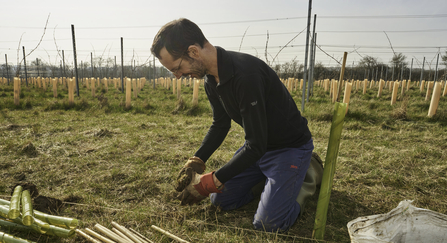What is it?
Agroforestry is farming with trees in the landscape. It includes both the integration of trees on farmland and the use of agricultural crops and livestock in woodlands. There are 4 main types of agroforestry in the UK:
- Silvopastoral agroforestry: the combination of trees and livestock including forest grazing, orchard grazing, wood pasture and integration of single trees into grazing fields.
- Silvoarable agroforestry: the combination of trees and crops including short rotation coppicing and alley cropping.
- Hedgerows, shelterbelts and riparian buffer strips are the most commonly seen types of agroforestry: separating land parcels, providing wind breaks and protecting water courses.
- Forest farming: crop cultivation within a forest environment, harvesting naturally occurring speciality crops, e.g. wild honey and botanicals and hazel coppicing.
Benefits for farmers:
- Trees help provide shelter and regulate air temperature for livestock and crops from all weathers including high winds, cold and hot temperatures. This increases animal welfare and crop productivity and quality.
- Providing shelter from wind also decreases soil erosion.
- Increasing biodiversity in the landscape through trees helps to increase the numbers of pollinators and pest predators. Having these trees within your cropping system helps them to reach further into the crop and have a greater impact.
- Tree cropping can form another enterprise in your business, diversifying your income. This could be from fruit and nut trees, coppicing or timber production.
- Certain species of trees such as walnut and willow can be beneficial for livestock, helping to keep flies away and providing a source for anthelmintics.
- Trees can also provide browse for livestock, fulfilling any additional dietary needs.
Benefits for wildlife:
- Adding strips of trees to cropland (especially riparian buffers) helps to reduce nutrient and pesticide run-off from fields and improves water quality and biodiversity in the waterways.
- Adding more trees into the landscape helps to provide more shelter and food for many different species as well as creating a better network of joined up trees to allow animals to travel through the landscape to find new mates and breeding grounds.
- Trees also sequester carbon from the air acting as an invaluable store for carbon.
- Trees have large and deep roots which help to increase the water carrying capacity of the land helping with natural flood management, and also improve soil health with extended mycorrhizal fungi.
Points to consider:
- It is important to take into consideration which tree species, crops and livestock breeds you will use as part of your agroforestry system as they will interact differently and need to be planned out to have the desired outcome.
- Taking into consideration the movements of the sun at different times of year is important when planting alley trees to ensure crops can receive enough sunlight at the right times of year.
- Trees will need to be managed just as hedgerows need to be managed so they can continue to provide the greatest benefits for your farm and for wildlife.
Useful resources:

Norfolk Wildlife Trust tree planting - Richard Osbourne
